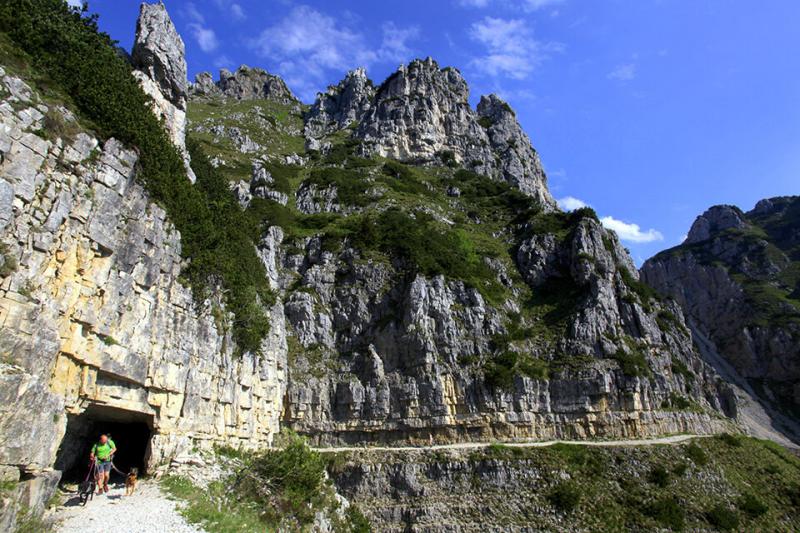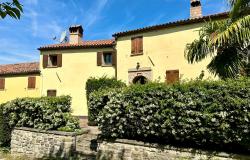Winter 1917. The war was raging all along the Italian Front, at the border between Austria-Hungary and Italy. In the midst of one of the coldest and snowiest winters of the century, the men of the 33rd Company of the Italian Army were tasked with the construction of a mule road on Veneto’s Mount Pasubio that was to secure the ridges of the mountain front still dangerously exposed to the enemy’s fire, and at the same time provide a new access road to Porte del Pasubio, a military camp set up right behind the front.
What the young men of the 33rd Army had in front of them was a wild, mostly unexplored, rugged mountainous territory that was still uncharted.
“An actual work plan didn’t exist because it was impossible to draw one up,” wrote tenant Ugo Cassina, one of the men who took part in the road construction.
And yet what these men accomplished, in the course of a few months, armed only with pickaxes and dynamite - and much determination - is considered one of the most striking feats of military engineering, what is known today as the Strada delle 52 Gallerie (Road of 52 Tunnels), a path carved into the mountain by way of 52 galleries.

[The men of the 33rd Company of the Italian Army, tasked with building the Strada delle 52 gallerie.]
Summer 2017. Fast forward 100 years and today, the Strada delle 52 Gallerie is a popular, and much beloved, hiking trail taken by thousands of people every year, who come here to marvel at the breathtaking views.
To call it just a 'hiking trail' though wouldn’t do it justice; the Strada delle 52 Gallerie is a piece of history that lives on. “It's a hundred years old and is the only artifact of the Great War to still be alive,” says Claudio Rigon, the curator of the exhibition currently on view in Schio’s Palazzo Fogazzaro marking 100 years since the road's construction. Organized by the Italian Alpine Club (CAI) of Schio, the Veneto town that is the gateway to the Strada, the exhibition was named “La Strada delle Gallerie ha 100 anni” (The Road of 52 Tunnels is 100 years old), to highlight the fact that the road is a living place, still capable of stirring emotions, as the number of people who hike it every year seems to suggest.
Using the writings by tenant Ugo Cassina and the black-and-white photographs by tenant Giuseppe Zappa, commander of the 33rd Mining Company, Rigon, who stumbled upon these documents a few years ago, has put together a brilliant exhibition that traces the story of the road’s construction, going into the hearts and minds of the men working on it. “The photographs make us see the mountain through the eyes of those men,” says Rigon. "Cassina's memoir, written as soon as the war ended, is the thread that strings together the exhibition."

[Claudio Rigon, curator of "La Strada delle Gallerie ha 100 anni" illustrates the exhibition to a group of journalists, including our Silvia Donati.]
Words and images together indeed give us a powerful account of what the project meant to the men involved in it, a passionate story of teamwork, camaraderie, pride, adventure, youth; a true epic that you can relive when you walk the Strada delle 52 Gallerie, imagining the men at work, the camps they had set up during the brutal winter, their daily life, sharing a lunch or a jug of wine, moments of simple ordinariness in the midst of war (all of this is documented in the many photos taken during construction, which you can see at the exhibition).
In a similar way, the sense of camaraderie, the feeling of being in a special place, the attachment to the road lives on in modern-day hikers; you'd only need to see them, smiling and eager, as they make their way up the mountain.
“The road had seduced us,” wrote Cassina in his diary. A hundred years later, it still does.

What you need to know to hike the Strada delle 52 Gallerie
The Strada delle 52 Gallerie winds its way through the rocky southern slope of the Pasubio, among spires, canyons and sheer walls. It begins at Bocchetta Campiglia (1216 m-3989 ft) and ends at Porte del Pasubio (1928m-6325 ft), where CAI’s Rifugio Papa is located (a cozy mountain hut where you can eat and sleep).
It has a total elevation gain of 784 meters (2572 feet) with some exposed traits; it is 6,3 km (3,9 mi) long, of which 2,3 km (1,4 mi) are in the tunnels. Seven of the 52 galleries are longer than 100 meters (328 ft); the 19th is the longest, at 318 meters (1043 ft); the 20th is the most spectacular, twisting over itself like a corkscrew. It takes about three hours to walk the trail uphill. A torch is required as the tunnels are not illuminated. Leave with an adequate supply of water as there are no sources along the trail; you'll need to reach Rifugio Papa to resupply.
“La Strada delle Gallerie ha 100 anni” is on view until September 24, 2017. For more information about the road and the exhibition, visit the dedicated website.













